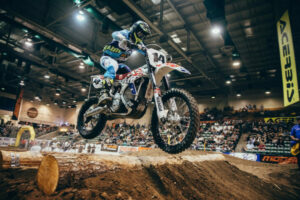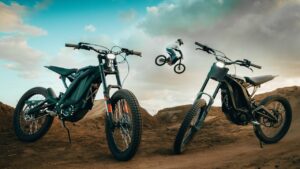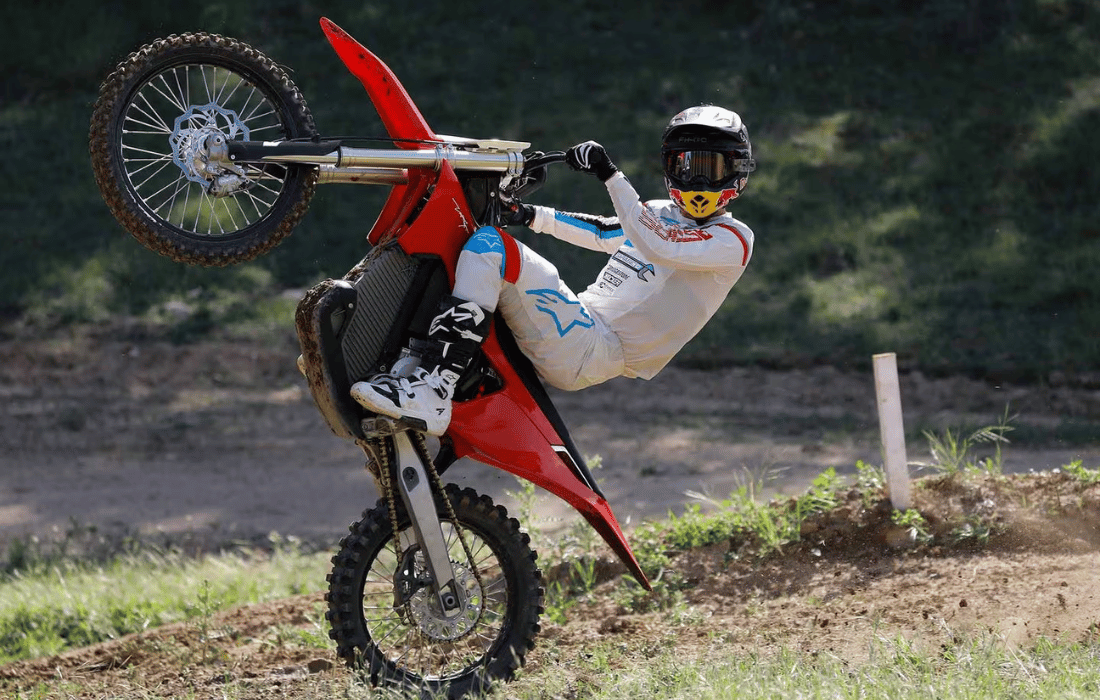Electric dirt bikes are no longer a futuristic concept—they’re here, and they’re making significant strides in the motocross world. From pioneering brands like Alta Motors to the technological marvels of today, such as the Stark VARG, these silent, powerful machines are reshaping off-road racing. While traditionalists may be skeptical about electrification in a sport deeply rooted in the roar of combustion engines, the undeniable advancements in electric dirt bike technology demand attention. This article delves into the history, current landscape, and potential future of electric dirt bikes, exploring the challenges, triumphs, and debates surrounding their integration into professional motocross and supercross.
The Evolution of Electric Dirt Bikes: From Alta to Stark
Alta Motors: The Trailblazer

Alta Motors was among the first manufacturers to introduce a legitimate electric dirt bike to the market. Founded in 2010, Alta aimed to prove that electric bikes could rival, if not surpass, their gas-powered counterparts. The Alta Redshift MX, launched in 2016, showcased impressive performance with a top speed of 65 mph, a lightweight aluminum frame, and near-instantaneous torque. Riders and industry insiders were intrigued. The Redshift MX demonstrated its capabilities in competitions, earning accolades for its power delivery and innovative design. Unfortunately, despite its groundbreaking technology, Alta Motors ceased operations in 2018 due to financial challenges. The company’s demise left a void in the market but also laid the groundwork for future innovators like Stark.
Stark Future: Setting New Standards
Enter the Stark VARG, a bike that many believe represents the pinnacle of electric dirt bike technology. With up to 80 horsepower and customizable ride modes, the Stark VARG is designed to outperform traditional 450cc gas-powered bikes. Stark Future, the company behind the VARG, has pushed the envelope with advanced engineering, including a carbon-fiber motor, a magnesium honeycomb casing, and over 100 adjustable power modes. Sebastien Tortelli, a motocross legend and Stark’s testing director, praised the VARG’s balanced chassis, nimble handling, and silent operation, calling it “a real motocross bike.” Riders can fine-tune the bike to mimic the characteristics of a 125cc two-stroke or a 650cc four-stroke, offering unmatched versatility.
Surron: Carving Its Niche
 While brands like Alta and Stark aim to compete with traditional motocross bikes, Surron has carved out a unique niche. Known for its smaller, lightweight electric dirt bikes, Surron caters to casual riders and urban enthusiasts. The Surron Light Bee, for example, offers a fun, accessible riding experience with less power output than the Stark VARG but at a significantly lower price point. Surron bikes are not direct competitors to Stark or gas-powered 250cc and 450cc machines but serve as an entry point for riders exploring electric options.
While brands like Alta and Stark aim to compete with traditional motocross bikes, Surron has carved out a unique niche. Known for its smaller, lightweight electric dirt bikes, Surron caters to casual riders and urban enthusiasts. The Surron Light Bee, for example, offers a fun, accessible riding experience with less power output than the Stark VARG but at a significantly lower price point. Surron bikes are not direct competitors to Stark or gas-powered 250cc and 450cc machines but serve as an entry point for riders exploring electric options.
On a personal note, I’ve watched kids in my neighborhood having an absolute blast on Surron bikes—popping wheelies and cruising around town—before taking them up into the nearby mountain trails. I have to admit, these bikes are impressive. The versatility to enjoy riding in town and then seamlessly hit the trails on a whim makes me want one for myself.
The Debate: Integrating Electric Bikes into Pro Supercross
The integration of electric dirt bikes into professional motocross and supercross circuits has sparked intense debate. As Davey Coombs, a key figure in AMA Pro Motocross and Supercross, explained on the Gypsy Tales podcast, the issue isn’t just about performance—it’s about fairness and the sport’s long-standing traditions.
The “Box” Dilemma
Coombs articulated a key challenge: how to create a standardized framework—or “box”—for electric bikes within the competitive landscape. Unlike gas-powered bikes, which are categorized by engine displacement (e.g., 250cc, 450cc), electric bikes operate on entirely different principles. Stark has proposed solutions, such as locking their bikes to specific power modes that mimic gas-powered equivalents. However, Coombs raised valid concerns about the potential for other manufacturers to exploit the lack of regulation. “What if a new brand comes in with a cheaper, faster bike that doesn’t adhere to the same standards?” he questioned. “How do you ensure an even playing field?”
MXGP’s Forward-Thinking Approach: An Electric Class in 2026
In contrast to the cautious approach of AMA Pro Racing, MXGP is taking proactive steps by introducing an electric class in 2026. This new division will run alongside the traditional MXGP championship, providing a dedicated platform for electric bikes to compete without disrupting the existing categories. This move could serve as a blueprint for other racing organizations, balancing the inclusion of electric bikes with the preservation of traditional racing formats.
Arenacross and the X-Pro Class
Closer to home, Arenacross is also leading the charge with its X-Pro class, set to debut in 2025. This innovative format pits electric and gas-powered bikes against each other in head-to-head clashes. By integrating electric bikes into existing formats, Arenacross is exploring ways to blend tradition with innovation, offering fans an exciting glimpse of what the future might hold for motocross.
Advantages of Electric Dirt Bikes
Despite the controversies, electric dirt bikes offer several undeniable benefits. The most obvious advantage is their silent operation, which allows riders to practice and race in urban areas without noise complaints. Noise restrictions have long limited motocross tracks in suburban and urban areas, but electric bikes could help solve this issue. The near-silent nature of these bikes is a game-changer for anyone tired of hearing, “You’re too loud!” while revving up for a practice session. Beyond their stealth, electric motors deliver instantaneous torque, providing unmatched acceleration. This characteristic gives electric dirt bikes an edge in tight corners and straight-line sprints, where power delivery is critical.
1. Customizability Like Never Before
Bikes like the Stark VARG allow riders to customize power delivery, engine braking, and traction control, offering a tailored riding experience. Riders can even adjust the bike to mimic the feel of different engine sizes, making the same bike suitable for a wide range of skill levels. This level of customization is unprecedented in motocross and could redefine how riders approach competition and training.
2. Reduced Maintenance
Electric bikes also require significantly less maintenance than their gas-powered counterparts. With no air filters, oil changes, or valve adjustments, electric dirt bikes simplify ownership and reduce costs over time. While traditionalists may miss the hands-on aspect of maintaining a gas-powered bike, the convenience of electric bikes is hard to overlook.
Challenges and Concerns
1. Battery Life and Range
Battery technology remains a limiting factor for electric dirt bikes. While the Stark VARG claims a range of up to six hours of light trail riding or 35 minutes of intense motocross use, this is still a constraint compared to gas-powered bikes, which can be refueled in minutes. Riders planning long enduro events or multi-hour trail rides may find electric bikes impractical without significant advancements in battery capacity and charging speed.
2. Charging Infrastructure
The availability of charging stations, especially in remote riding locations, is another hurdle. However, initiatives like electric bike parks with on-site charging are beginning to address this issue. The question remains: will charging infrastructure grow quickly enough to meet the needs of electric dirt bike riders?
3. Cost
Electric dirt bikes are often more expensive upfront than their gas-powered counterparts. The Stark VARG, for example, starts at €11,900. While reduced maintenance costs may offset this over time, the high initial investment could deter some riders. Additionally, the cost of replacement batteries—if and when needed—adds another layer of financial consideration.
Perspectives from Top Riders
The opinions of professional riders who have tested electric dirt bikes provide valuable insights into their performance and potential use cases. Sebastien Tortelli, a former motocross world champion and Stark VARG’s testing director, expressed enthusiasm for the bike’s performance and versatility. “The very first impression was from the outright performance; it was much more than I expected,” Tortelli said. “The chassis is balanced as well as nimble. The light weight means you can really move around it with ease and attack those jumps and sections. I feel awesome on the track, and I can race with this bike.”
Josh Hill, another notable rider, has also been vocal about his experience with electric bikes. Hill tested the Stark VARG extensively and praised its power delivery and handling. “It’s an amazing experience to ride in silence,” Hill noted. “You can hear the way the bike picks up traction, the impact of the stones and the jumps. It’s an amazing sensation.” His feedback highlights the unique appeal of electric dirt bikes, which offer a quieter yet equally intense riding experience.
Additionally, Haiden Deegan, one of Motocross’s rising stars, has been seen testing electric bikes like the Surron Light Bee for fun. While he obviously hasn’t and likely won’t ever switch to electric for competition, his involvement shows how younger riders are embracing the technology as a supplementary tool for training and recreation.
The Environmental Argument: A Misguided Focus
One of the most controversial aspects of electric dirt bikes is their perceived environmental benefit. While electric vehicles are often lauded for their reduced emissions, motocross enthusiasts are more interested in their performance and practicality. The truth is, most riders aren’t switching to electric bikes to save the planet—they’re drawn to the innovative features and the potential for new riding opportunities. Combustion-engine motorcycles will remain a staple of the sport for decades to come. Electric dirt bikes represent an evolution, not a replacement, and the focus should remain on their performance rather than their eco-credentials.
The Future: Coexistence of Gas and Electric
As the technology behind electric dirt bikes continues to improve, it’s likely that the motocross world will embrace a hybrid model where gas-powered and electric bikes coexist. Events like the Arenacross X-Pro class, which pits electric and gas bikes against each other, provide a glimpse of this future. This integration allows for innovation while respecting the sport’s rich traditions.
Organizations like MXGP and Arenacross are leading the way by creating dedicated electric classes or hybrid competitions. These initiatives will enable electric dirt bikes to carve out their place in the sport without alienating traditional riders and fans. Over time, as battery technology advances and costs decrease, we may see even greater adoption of electric bikes in both professional and recreational settings.
Conclusion: The Silent Revolution
Electric dirt bikes are no longer a fringe concept—they’re an exciting and rapidly evolving part of motocross. Brands like Stark Future and Surron are pushing the boundaries of what’s possible, offering riders new experiences and opportunities. While challenges such as battery life, cost, and regulation remain, the motocross industry is taking meaningful steps to address them.
The future of motocross may not be entirely electric, but electric bikes are here to stay. With their unique combination of instant torque, customizability, and reduced maintenance, they offer a fresh perspective on a sport steeped in tradition. As riders and fans continue to explore this new frontier, one thing is clear: the silent revolution is just getting started.







